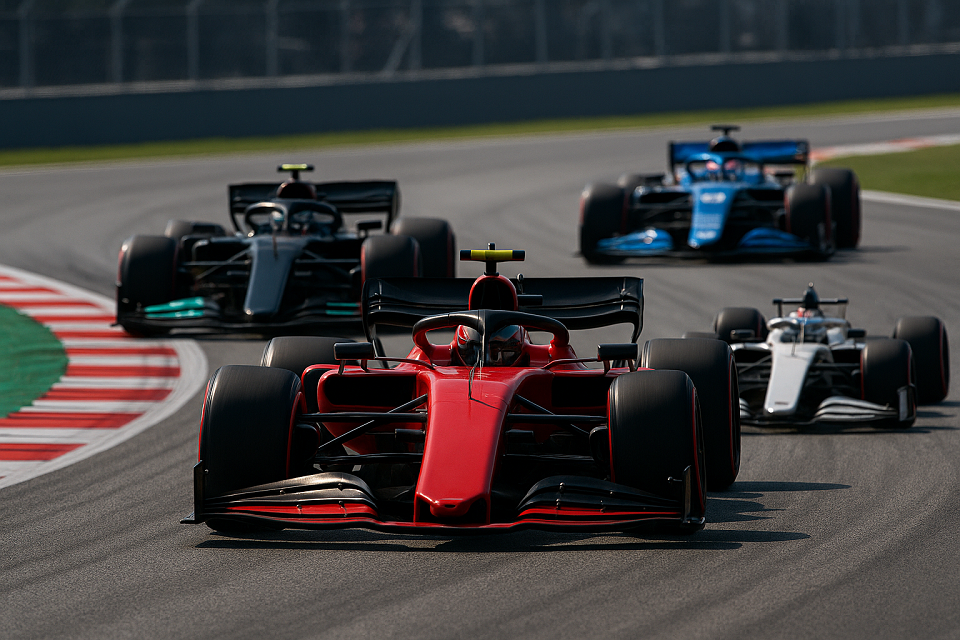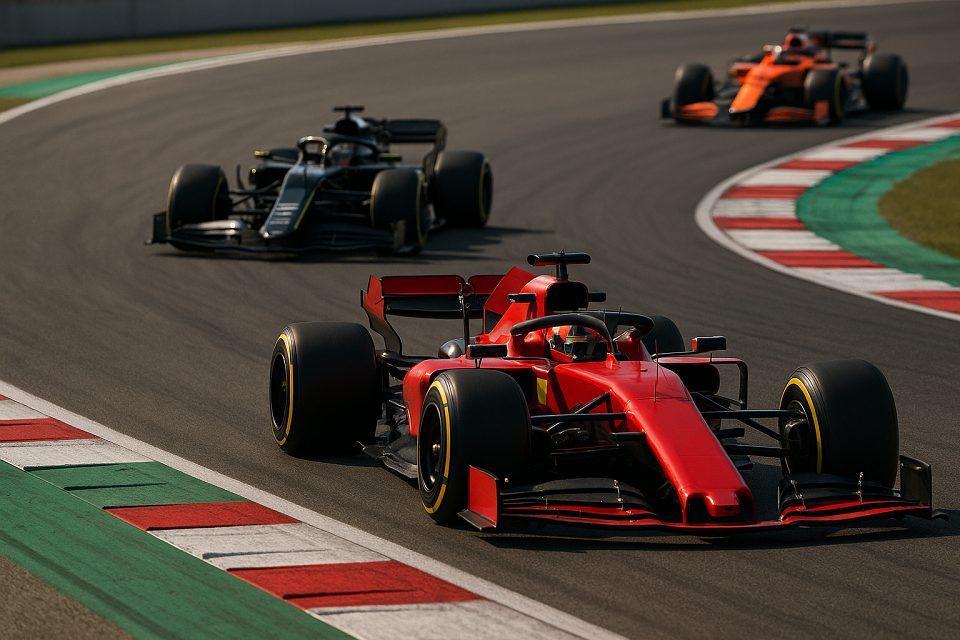Introduction
Formula 1 (F1) race cars are the pinnacle of automotive engineering, built for speed, precision, and thrill. If you’re curious about how fast these machines can go or wondering how they compare to the car you might buy, you’re in the right place! This guide breaks down that How Fast Do F1 Race Cars Go? In simple terms, explores what makes these cars so fast, and connects it to what you might consider when buying a road car. Let’s dive into the world of F1 speed with an engaging, easy-to-read journey.

What Is Formula 1?
Formula 1 is the world’s top motorsport, where teams design and race single-seater cars on tracks around the globe. These cars are not like your everyday sedan or SUV they’re built for one purpose: to go as fast as possible while staying safe and following strict rules. Think of F1 cars as the superheroes of the car world, designed for jaw-dropping performance.
F1 races happen on circuits like Monaco, Silverstone, and Monza, each with unique challenges like tight corners or long straights. The speed of an F1 car depends on the track, the car’s setup, and the driver’s skill. Let’s explore just how fast these cars can go.
Top Speeds of F1 Cars: The Numbers
F1 cars are incredibly fast, but their speed varies depending on the track and conditions. Here’s a quick look at their top speeds:
- Average Top Speed: Most F1 cars can hit speeds between 186-223 mph (300-360 km/h) on long straights.
- Record-Breaking Speed: The fastest recorded speed in an F1 race was 231.4 mph (372.5 km/h) by Valtteri Bottas in 2016 at the Mexican Grand Prix.
- Typical Race Speed: During a race, cars average around 124-155 mph (200-250 km/h), depending on the track’s layout.
To put this in perspective, a typical family car like a Toyota Corolla tops out at about 120 mph (193 km/h). F1 cars are in a league of their own!
Why Are F1 Cars So Fast?
F1 cars aren’t just fast because of powerful engines. Several factors work together to make them speed machines. Let’s break it down in simple terms:
- Lightweight Design: F1 cars weigh around 1,746 pounds (792 kg), including the driver. Compare that to a Honda Civic, which weighs about 2,800 pounds. Less weight means quicker acceleration.
- Powerful Engines: F1 cars use 1.6-liter V6 hybrid engines that produce over 1,000 horsepower. Your average road car? About 150-200 horsepower.
- Aerodynamics: The sleek shape, wings, and spoilers reduce air resistance and create “downforce,” which pushes the car onto the track for better grip at high speeds.
- Advanced Tires: F1 tires are designed to grip the track like glue, allowing cars to take corners at speeds that would make a regular car spin out.
- Driver Skill: F1 drivers are some of the best in the world, trained to push cars to their limits while staying in control.
These elements combine to make F1 cars not just fast but also agile and precise.
How F1 Speeds Compare to Road Cars
If you’re thinking about buying a car, you might wonder how F1 speeds stack up against road cars. Let’s compare F1 cars to some popular vehicles and high-performance supercars:
| Vehicle Type | Top Speed (mph) | 0-60 mph Time | Horsepower |
|---|---|---|---|
| F1 Car (2025 season) | 186-223+ | ~1.7 seconds | ~1,000 |
| Toyota Corolla (2023) | ~120 | ~8 seconds | ~169 |
| Tesla Model 3 Performance | ~162 | ~3.1 seconds | ~510 |
| Porsche 911 Turbo S | ~205 | ~2.6 seconds | ~640 |
| Bugatti Chiron | ~261 | ~2.3 seconds | ~1,479 |
Key Takeaways:
- F1 vs. Family Cars: A family car like the Corolla is built for comfort and efficiency, not speed. It’s no match for an F1 car’s raw power.
- F1 vs. Supercars: Even high-end supercars like the Bugatti Chiron can’t match F1 cars in a race due to F1’s superior handling and aerodynamics, despite the Chiron’s higher top speed.
- Relevance for Buyers: If you’re buying a car, consider what you need daily commuting doesn’t require F1-level speed, but a sports car might satisfy your need for thrill.
How Track Design Affects F1 Speed
Not all F1 tracks are created equal. Some are built for speed, while others test a car’s agility. Here’s how track design impacts F1 speeds:
- High-Speed Tracks: Tracks like Monza (Italy) and Spa-Francorchamps (Belgium) have long straights where cars can hit top speeds of 200+ mph.
- Technical Tracks: Circuits like Monaco or Singapore have tight corners, so cars slow down to 30-50 mph in turns but still average 100-130 mph.
- Weather Impact: Rain reduces grip, slowing cars down for safety. In wet conditions, speeds might drop by 10-20%.
For example, at Monza, cars spend more time at full throttle, pushing their engines to the max. In Monaco, drivers brake hard and accelerate quickly out of corners, relying on the car’s agility.
Acceleration: From 0 to Wow!
F1 cars aren’t just about top speed they accelerate like nothing else. An F1 car can go from 0 to 60 mph in about 1.7 seconds. To give you an idea:
- A Tesla Model 3 Performance takes about 3.1 seconds.
- A typical compact car takes 7-9 seconds.
This lightning-fast acceleration comes from the car’s powerful engine and low weight. Imagine pressing the gas pedal and feeling like you’re being launched into a roller coaster that’s what F1 drivers experience!
Braking: Stopping as Fast as They Go
F1 cars don’t just go fast; they stop incredibly quickly, too. Thanks to advanced brakes and aerodynamics, an F1 car can slow from 200 mph to a complete stop in about 4 seconds. Compare that to a road car, which might take twice as long to stop from 100 mph.
This braking power is crucial for navigating tight corners and avoiding collisions. For car buyers, this highlights the importance of good brakes in performance cars, especially if you enjoy spirited driving.
How F1 Technology Influences Road Cars
F1 cars are like labs on wheels, testing tech that often ends up in the cars we drive. Here’s how F1 innovations can impact your car-buying decision:
- Hybrid Engines: F1’s hybrid technology has inspired efficient yet powerful engines in cars like the Toyota Prius or BMW i8.
- Aerodynamics: Sports cars like the Porsche 911 use F1-inspired spoilers to improve stability at high speeds.
- Materials: Lightweight carbon fiber from F1 is now used in high-end cars to reduce weight and improve fuel efficiency.
- Safety Features: F1’s focus on safety led to stronger chassis designs and features like ABS in road cars.
When shopping for a car, look for models with hybrid options or advanced safety features if you want a taste of F1 tech in your daily drive.
Challenges of Driving an F1 Car
Driving an F1 car at these speeds isn’t easy. Here’s what drivers face:
- G-Forces: In corners, drivers experience forces up to 5G (five times their body weight), making it feel like they’re being crushed.
- Precision: At 200 mph, a tiny mistake can lead to a crash. Drivers need razor-sharp focus.
- Physical Fitness: Drivers train like athletes to handle the physical strain of high speeds and G-forces.
For car buyers, this is a reminder that high-performance cars require skill and responsibility to drive safely.
F1 Speed Records and Milestones
F1 has seen some incredible speed moments over the years. Here are a few highlights:
- Fastest Race Lap: Max Verstappen holds the record for the fastest lap at the 2023 Austrian Grand Prix, averaging 164.4 mph (264.6 km/h).
- Fastest Qualifying Lap: Lewis Hamilton set a blistering 163.9 mph (263.7 km/h) average speed during qualifying at Monza in 2020.
- Highest Top Speed: Valtteri Bottas’ 231.4 mph (372.5 km/h) in Mexico, 2016, remains the fastest recorded speed in a race.
These records show how F1 pushes the boundaries of speed and technology year after year.

What This Means for Car Buyers
If you’re researching cars to buy, F1 speeds might seem like a distant dream, but there are lessons to take away:
- Prioritize Your Needs: If you want speed, consider sports cars like the Mazda MX-5 Miata or Ford Mustang. They’re fun but practical for everyday use.
- Safety First: F1’s focus on safety reminds us to check for features like automatic emergency braking and lane-keeping assist in new cars.
- Test Drive: High-performance cars inspired by F1 tech (like hybrids or turbocharged models) can offer thrilling drives. Test them to see what fits your style.
- Budget Considerations: F1 cars cost millions, but you can find performance cars starting at $30,000-$50,000 that borrow F1 tech.
When choosing a car, think about how much speed you need versus practicality, fuel economy, and comfort.
FAQs About F1 Car Speeds
How fast can an F1 car go compared to a regular car?
F1 cars can reach speeds over 223 mph, while most regular cars top out at 100-150 mph. F1 cars also accelerate much faster, hitting 60 mph in under 2 seconds.
What’s the fastest F1 car ever?
The fastest recorded speed was 231.4 mph by Valtteri Bottas in 2016. Modern F1 cars are slightly slower due to rule changes but still hit 200+ mph.
Can road cars ever match F1 speeds?
Some supercars like the Bugatti Chiron can hit higher top speeds, but F1 cars are faster in races due to their handling, aerodynamics, and acceleration.
Why don’t F1 cars go faster?
F1 rules limit engine size, aerodynamics, and other factors to ensure safety and fair competition. Without these limits, cars could go even faster!
How do F1 speeds affect car buying?
F1 tech trickles down to road cars, improving efficiency, safety, and performance. Look for cars with hybrid engines or advanced aerodynamics for a touch of F1.
Fun Facts About F1 Speeds
- Pit Stops: F1 cars can go from 60 mph to a complete stop in under 2 seconds during pit stops.
- Fuel Efficiency: Despite their speed, F1 cars use hybrid tech to save fuel, burning about 2.5 gallons per race.
- Cornering Speeds: F1 cars can take corners at 100 mph that a road car would struggle with at 30 mph.
The Future of F1 Speed
F1 is always evolving. By 2026, new rules will introduce more sustainable engines and lighter cars, potentially changing top speeds. Teams are also experimenting with electric and hydrogen tech, which could influence future road cars. For buyers, this means more eco-friendly, high-performance options in the coming years.
Conclusion
F1 race cars are marvels of speed, hitting 186-223 mph and accelerating faster than almost anything on the road. Their lightweight design, powerful engines, and cutting-edge tech make them the kings of motorsport. While you might not drive an F1 car, their technology influences the cars you can buy, from hybrids to safety features. When choosing your next car, think about what matters speed, efficiency, or comfort and let F1 inspire your love for driving.
If you’re excited about F1 or want to explore cars with a bit of that racing spirit, test drive a performance model and feel the thrill for yourself!


